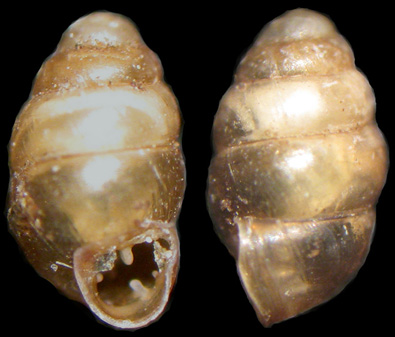
Classification
Domain: Eukarya
Kingdom: Animalia
Phylum: Mollusca
Class: Gastropoda
Order: Stylommatophora
Family: Pupillidae
Genus: Vertigo
Species: Vertigo tridentata
Vertigo tridentata Wolf (1870)
Common Name: Honey Vertigo
Domain: Vertigo tridentata is placed in the domain Eukarya. Characteristics of all Eukarya, or eukaryotes, include the genetic material DNA which is found within a true nucleus and membrane bound organelles (Hickman, 2009).
Kingdom: Animalia, or Metazoa, is a kingdom that consists of organisms which are heterotrophic and also multicellular lacking a cell wall. Being heterotrophic denotes that the organism must search for their food and obtain it from other organisms rather than having the ability to produce it themselves (Encyclopedia of Life, 2011). This species of snail falls within the kingdom Animalia because they produce their own food and are multicellular organisms.
Phylum: Vertigo tridentata is then placed in the phylum Mollusca due to many distinct features. Organisms in the phylum Mollusca contain a head, a thick, muscular foot, and a visceral mass and most molluscs also have external gills (Hickman, 2009).
Class: The largest group of molluscs belongs to the class Gastropoda, which means "belly foots". Gastropods have the ability to turn their visceral mass 180 degrees called torsion and most have hard, coiling shells. Many of the gastropods also have a radula which is used to scrape algae off rocks or attack other molluscs in cases of a carnivorous gastropod (Hickman, 2009).
Order: Vertigo tridentata is classified in the order Stylommatophora because of its unique retractable tentacles. They have two pairs of tentacles, a smaller and larger pair, and their eyes are positioned at the end of the two large tentacles. Most organisms within the order Stylommatophora are strictly terrestrial (Encyclopedia of Life, 2011).
Family: The family of Pupillidae is classified by the amount of lamellae they contain. The lamellae of a snail are small, short, tooth-like projections at the aperture, or opening of the shell (Encyclopedia of Life, 2011).
Genus: Vertigo is usually characterized by 4-6 lamellae in each organism and a shell that ranges from a yellow-brown color to a dark brown color. Vertigo from the Latin language means "whirling" or "to turn" (Pilsbry, 1948).
Species: The full species name of this organism is Vertigo tridentata and there are a few specific characteristics which set is aside and different than the other Vertigo snails. Vertigo tridentata have an oblong, coiled shell which is usually a honey yellow color. This is where they get their common name from, Honey Vertigo. This species has four lamellae at the aperture and the outer lips of the aperture project and curl outward. Vertigo tridentata was founded by Mr. Wolf in 1870 which is also why this particular species can also be seen written as Vertigo tridentata Wolf (1870). Vertigo tridentata Wolf (1870) is the technical way to identify this species (Pilsbry, 1948).
Next, explore the
Habitat of the Vertigo tridentata snail.
Or, return to the Home page.
